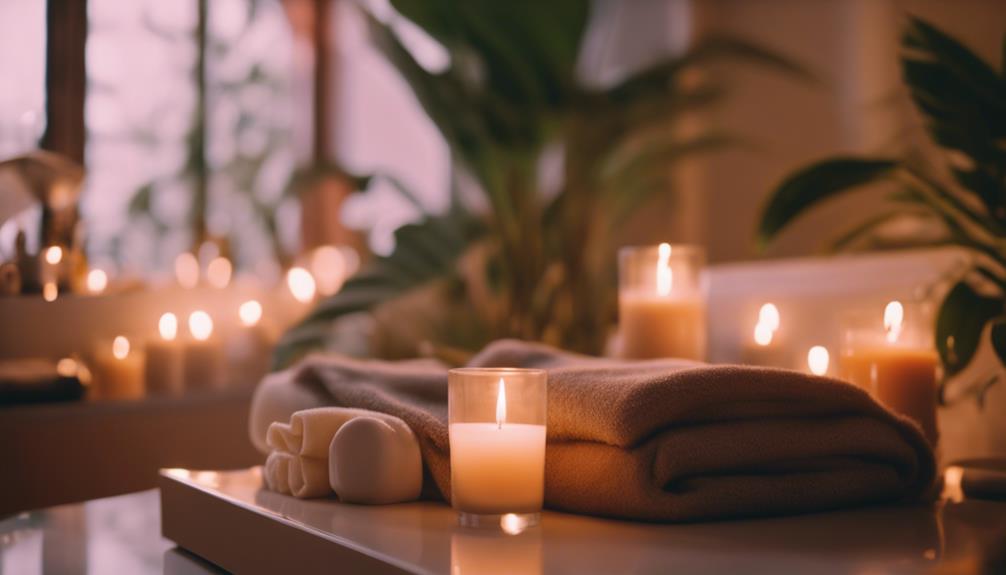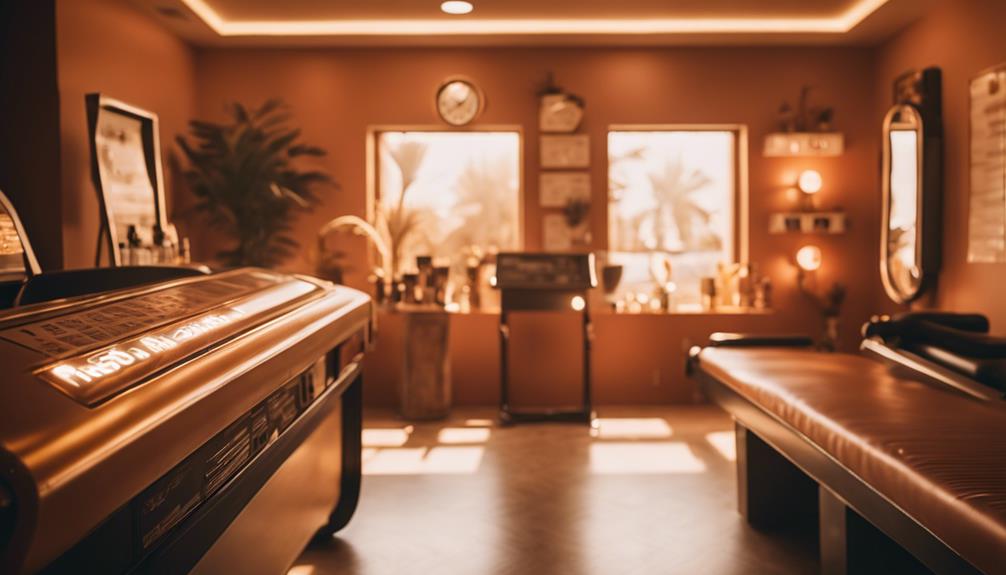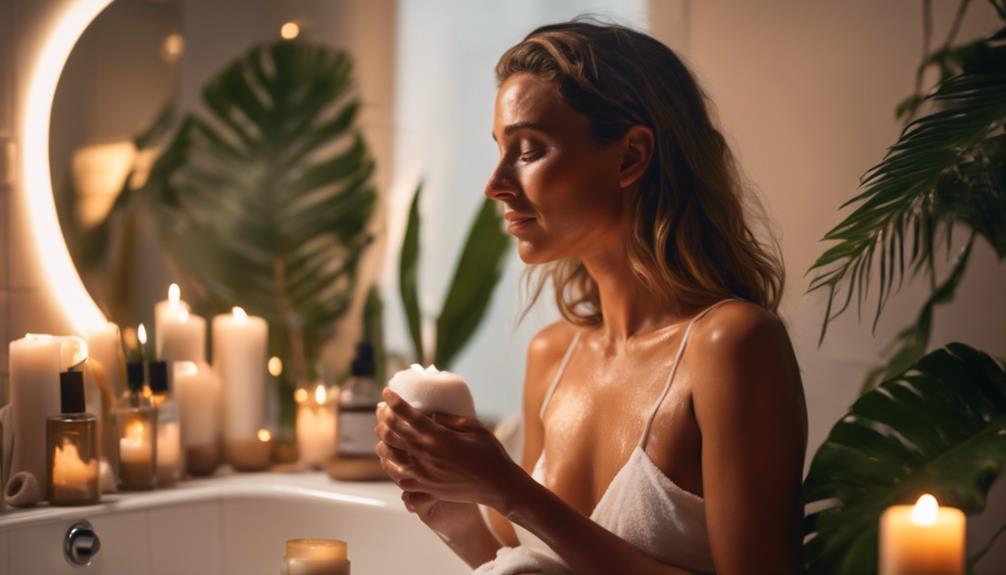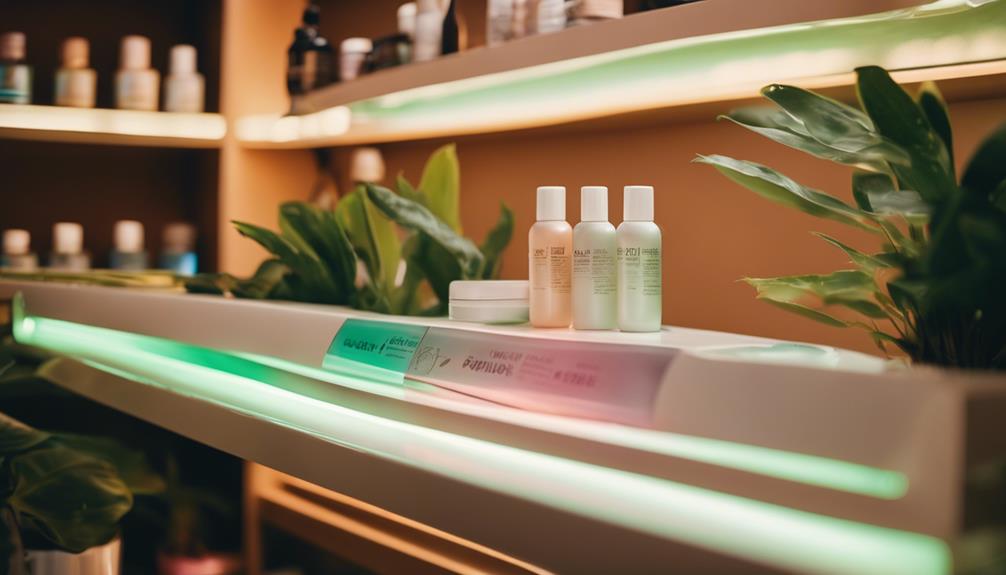Mastering tanning bed sessions is all about finding that perfect blend of fun and safety. First, you've gotta know your skin type—fair skin? Proceed with caution! Exfoliate a day before, and hydrate yourself 'cause glowing skin loves water. Start with short sessions and listen to your skin; if it feels itchy, cut back! Aim to hit the tanning bed two times a week and always apply moisturizer afterward. Oh, and don't forget to protect sensitive areas—with sunscreen or a towel—your skin will thank you! Stick around, and you'll discover more tips for achieving that sought-after sun-kissed glow!
Key Takeaways
- Identify your skin type to choose the appropriate tanning lotion and set realistic expectations for your tanning sessions.
- Exfoliate and moisturize your skin 24 hours before tanning to enhance absorption and achieve an even tan.
- Start with shorter tanning sessions and gradually increase duration based on your skin's tolerance and reactions.
- Schedule sessions during morning or early afternoon to take advantage of milder UV exposure and avoid peak hours.
Understanding Skin Types
Understanding your skin type is essential for tailoring your tanning approach and avoiding painful burns.
If you've got fair skin that burns easily, you'll want to be extra cautious. More melanin means less chance of turning into a lobster, right?
Sensitive skin? You might need to take extra precautions to dodge any nasty reactions. Have you ever tried a product that just didn't vibe with your skin?
Consulting a dermatologist can help you get an accurate assessment, so you're not guessing.
Plus, knowing your skin type helps you pick the right tanning lotion. It's like choosing the perfect outfit—only this time, it's for your skin.
Preparation for Tanning

Before tanning, make sure to exfoliate your skin 24 hours in advance to remove dead cells and prepare for an even tan. It's like giving your skin a fresh start! After that, slather on a light moisturizer to keep things smooth. Remember, heavy creams can be a no-no, as they might keep your tanning lotion from soaking in. And hey, don't forget to hydrate! Drinking water helps your skin glow.
| Step | Action | Why It Matters |
|---|---|---|
| 1. Exfoliate | Do it 24 hours before | Removes dead skin for an even tan |
| 2. Moisturize | Apply a light moisturizer | Enhances skin texture |
| 3. Avoid Heavy Products | Skip thick creams | Helps tan lotion absorb better |
| 4. Hydrate | Drink plenty of water | Keeps skin smooth and radiant |
| 5. Schedule | Plan your tanning sessions | Consistency leads to better results |
Optimal Session Practices

After prepping your skin, it's time to focus on how to make the most of your tanning sessions for a safe and effective glow. You wanna avoid looking like a lobster, right? Here are some tips:
- Start Small: Begin with shorter sessions to help your skin adjust to the UV rays.
- Watch Your Skin: Keep an eye on how your skin reacts. If it starts to feel irritated, cut back on time.
- Know Your Limits: Different skin types need different session lengths, so don't push it!
- Ask the Pros: Don't hesitate to chat with the salon staff for personalized advice.
With these tips, you'll be on your way to that perfect tan without the sunburn!
Timing and Frequency

Choosing the right time for your tanning sessions can greatly impact your results and skin health.
You'll find that morning or early afternoon sessions give you a gentler UV exposure, which is a win! But avoid those peak UV hours—trust me, you don't want to end up looking like a lobster.
If you've got fair or sensitive skin, pay attention to how your skin reacts during sessions. It's all about listening to your body.
Aim for about twice a week, spacing out your sessions by 72 hours for the best results. So, pencil in those tanning dates and get ready to glow!
Just remember, patience is key; good things take time, including that perfect tan!
Post-Tanning Skin Care

To keep your skin hydrated and enhance your tan, apply moisturizer immediately after your tanning session. Trust me, your skin will thank you!
Here's what you should do next:
- Use aloe vera—it's soothing and helps calm any irritation.
- Skip hot showers for at least 24 hours; they can wash away your hard-earned glow.
- Gently exfoliate after a day to keep that tan looking fresh, but don't overdo it!
- Drink plenty of water; hydration is key for maintaining that fabulous tan.
Protecting Sensitive Areas

While maintaining your tan, it's important to pay special attention to sensitive areas of your skin to prevent burns and irritation during tanning sessions.
You know those moles or scars? They need extra love! Slather on some sunscreen or a barrier cream to keep them safe. You can even use protective stickers or bandages to shield those delicate spots.
Got a favorite towel? Use it to cover sensitive areas while you soak up the sun—think of it as your own mini tanning fort!
And if you're unsure about how to protect your skin, don't hesitate to chat with a dermatologist.
Additional Resources

Explore a variety of additional resources to enhance your tanning experience and guarantee safe practices. You don't want to end up looking like a lobster, right? Check out these handy tips:
- Skin Type Guide: Learn about your skin type to choose the perfect tanning method.
- Tanning FAQs: Find answers to common questions about tanning beds and aftercare.
- Tanning Products Reviews: Check out reviews on lotions and oils to find what works best for you.
- Expert Blogs and Videos: Follow pros on social media for tips and tricks to up your tanning game.
With these resources, you'll be well on your way to achieving that sun-kissed glow safely and effectively!
Happy tanning!
Frequently Asked Questions
How Can I Extend the Longevity of My Tan?
To extend the longevity of your tan, moisturize daily, hydrate your skin, and gently exfoliate to remove dead cells. Avoid hot showers and harsh products that can strip your skin and fade your tan quickly.
What Are the Signs of Overexposure to UV Light?
Signs of overexposure to UV light include redness, peeling skin, and discomfort. You might also notice increased sensitivity or blistering. If you experience these, it's essential to stop tanning and allow your skin to heal.
Can I Tan if I Have a Sunburn?
You shouldn't tan if you have a sunburn. It can worsen the burn and prolong healing. Instead, focus on soothing your skin with aloe vera and hydration before considering any tanning sessions.
Are There Any Dietary Tips for Better Tanning Results?
To enhance your tanning results, eat foods rich in beta-carotene, like carrots and sweet potatoes. Stay hydrated, and consider foods high in antioxidants, such as berries, to promote healthy skin and a lasting tan.
How Do Different Tanning Lotions Affect My Tan?
Different tanning lotions can considerably affect your tan's depth and longevity. By choosing a lotion suited to your skin type, you enhance melanin production, ensuring a more even, vibrant tan while minimizing the risk of irritation.
Conclusion
So, there you have it! Mastering tanning bed sessions can be fun and rewarding.
Just think about Jake, who prepped like a champ, followed the timing tips, and came out with a golden glow that made everyone jealous!
Remember, it's all about understanding your skin and taking care of it.
So, grab those lotions and get ready to shine—just don't forget the sunscreen when you step out in the sun!
Happy tanning!










